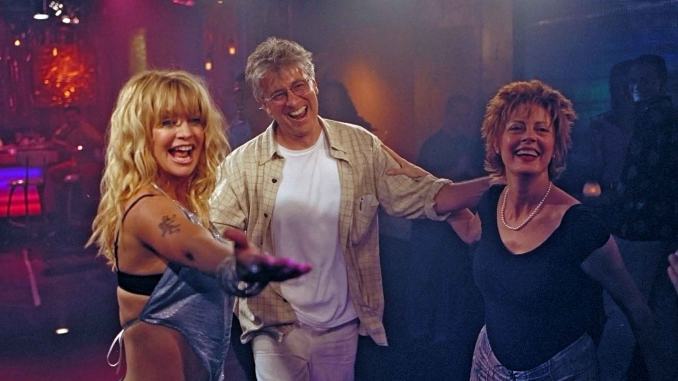The Banger Sisters‘ Bittersweet Legacy Is That of Second-Wave Feminism

“Jim Morrison is a ghost, and so are you,” a young disgruntled suit barks at Suzette (Goldie Hawn) in the back hallway of Whisky a Go Go. Once an infamous barmaid of the celebrated L.A. music club, Suzette is having trouble with this new management. He disapproves of her beatnik shades, low-cut tanks and loose approach to work. She tries to convince him that she’s the spirit of the place and the last to remember a bygone era, but this manager couldn’t care less. He has a younger, edgier clientele to cater to.
Suzette sits alone in her Boho-chic apartment, looking through old photos, without a job but with a mountain of debt. She remembers the fabulous days of 1970s rock ‘n’ roll when she and her best friend Vin, or Vinnie, were “The Banger Sisters,” wild groupies posing on a “War Is Over” billboard. Sans any other direction in her life, Suzette sets out on a road trip to Phoenix to reconnect with her old accomplice and maybe ask for a bit of money.
In his review of writer/director Bob Dolman’s debut feature, The Banger Sisters, Roger Ebert called the film “pretty thin” while adding, “but you grin while you watch it.” The grin is still there 20 years later, but time has filled out the film. The vanishing ‘70s are even more remote. The upstart management is now fully part of the establishment. Watching The Banger Sisters today, we can forgive some of the script’s shortcomings for its stellar performances and what it captures about the changing history of second-wave feminism at the turn of the new millennium.
The script is deceptively simple. It’s the classic “worlds collide” plot when Suzette finally sees Vin (Susan Sarandon), and the pair realize how opposite they’ve become. Suzette is the carefree “flower,” while Vin is an uptight mom who now goes by her full name Lavinia and dresses “the same shade as the department of motor vehicles.” And it works, because Hawn and Sarandon are just fucking killer, man.
Hawn sets the tone right off the bat. She embodies the hip chick who keeps things cool. She’s always in controlled flight, drifting, with effortless humor and gentleness, through each scene. Suzette is the film’s muse that keeps the narrative flowing and easy-going.
Then she meets the immovable earthly force of Sarandon. Her Lavinia is a tightly wound coil, kept in check by bourgeois trappings. Sarandon brilliantly finds moments for Lavinia to tighten herself up even further with a twinkle in her eye. This gives her a great starting point because Lavinia is the character who changes the most. At first, she seems complete in herself, but the veneer starts to fall away. “I’ve lost me,” she confesses to herself and her family. She’s been so busy being a wife, mom or charity volunteer that she’s forgotten who she is. To find out, she has to reconnect with who she was.
What makes The Banger Sisters interesting is its use of “the groupie.” These semi-mythical figures are from a particular moment in the 1970s when sexual liberation, free love, road culture and rock music seemed to coalesce in primarily young white women. The ideal figure of the groupie was that of a fan, muse, lover and confidant—all rolled into one. We know the lifestyle wasn’t as cheery as Suzette tells us through literal rose-colored glasses. (Rent Almost Famous and ask her daughter, Kate Hudson, about the darker side of groupiedom.)
Nevertheless, Dolman uses the image of the groupie to ground Suzette and Vin in a period of history—one which Hawn and Sarandon know intimately. (Hawn got her start in the late 1960s as a dancer at Whisky a Go Go.) No matter how many years go by, because of the groupie, The Banger Sisters will always comment on not just the American 1970s but also “how far we’ve come” since then. The Banger Sisters poignantly charts the history of this cruel optimism. In her most optimistic or naïve form, the groupie embodies many midcentury hopes. They represented a free sexual culture unburdened by old-school regulations or repressions. But the groupie also illustrates the disappointments of its age. The groupies’ disappearance from popular culture parallels the failure of those hopes to materialize. It may have been difficult to notice in 2002, but in 2022, we have the privilege of double vision. We can see where 2002 sets itself apart from the 1970s and how we, in 2022, look at the early 2000s. It’s this extra distance that reveals the film’s hidden depths.
-

-

-

-

-

-

-

-

-

-

-

-

-

-

-

-

-

-

-

-

-

-

-

-

-

-

-

-

-

-

-

-

-

-

-

-

-

-

-

-








































